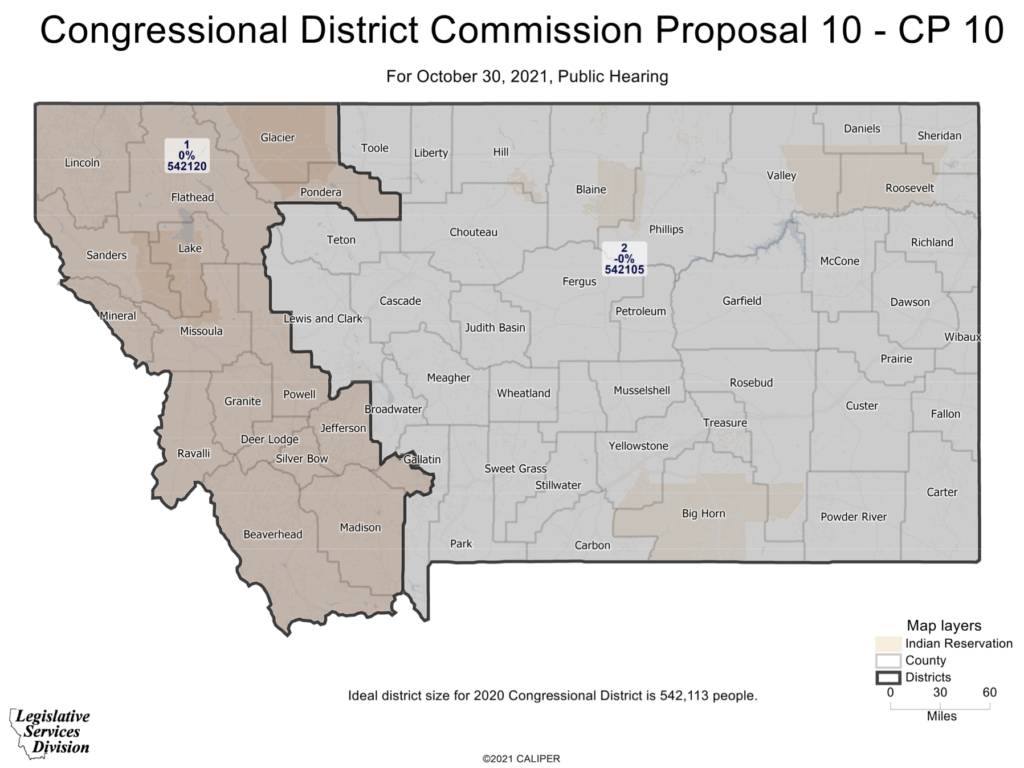Now is the time for you to exercise your civic duty on deciding the U.S. congressional districts in Montana. The information below will help you evaluate the proposed maps and submit your public comments. Follow the links to navigate this page:
Map Criteria | Proposed Maps | Observations | Submit Your Public Comments
Information updated on Monday, October 25, 2021
Map Criteria
The Montana Districting and Apportionment Commission is tasked with drawing the lines for the two U.S. House districts this year, and next year will be responsible for the state legislative redistricting. Below are the required criteria, as well as the goals the committee agreed to consider. Read more about this here.
Mandatory Criteria
- As equal in population as is practicable
- Protection of minority voting rights
- Compact territory
- Contiguous, meaning a district must be in one piece
Goals
- No map may unduly favor a political party
- Attempt to minimize dividing cities, towns, counties, and federal reservations
- Keep communities of interest intact
- May consider the competitiveness of districts
Final Two Maps
The Commission has narrowed down the number of final maps to two. On Saturday, October 30 the Commission will have a day-long hearing from public comment. Your input is needed now more than ever. Click below to submit comments on Map Proposals 10 and 11.
The Commission will make their decision no later than November 14, 2021.
For more analysis on these maps, check out the following resources. They provide a quick overview of each map and how it splits the population. FiveThirtyEight provides more information on the partisan divide of each proposed map.
Observations for Gallatin County
The final two maps under consideration are variations of the previous maps. Here are a few observations for the final maps:
Map #10
- Divides Gallatin County, separating the communities of Gallatin Gateway and Big Sky from the rest of Gallatin County.
- Separates the cities of Bozeman and Livingston from one another, two communities that have long-standing economic and cultural ties.
- Does not create a competitive district, which means that it unduly favors one political party.

Map #11
- Keeps Gallatin and Park counties together, which have strong and longtime economic and cultural ties to one another.
- Keeps the resort areas of Big Sky, Whitefish, and West Yellowstone in the same district. These resort communities have shared interests, challenges, and understanding.
- Creates one competitive district that any political party can win.
- Empowers Native voters because the competitive district will have a reservation. This means that every candidate will have to rely on Native votes to win the district, thus ensuring minority voices are heard.

Submit Your Comments
With the above observations in mind, plus your own that you gather from your research, you can comment directly on each proposed map for the Commission to read.
Comments on the proposed maps can be as simple as
- “This proposed map divides Gallatin County, which goes against your agreed-to goal of keeping cities in tact.”
- “This proposed map favors one political party.”
- “This proposed map has a federal reservation in the competitive district, which protects minority voting rights.”
(If you need help with making comments directly on the proposed maps, watch this short tutorial.)
Submit your comments directly on the interactive maps or through written comments by Thursday, October 28 at 5:00 pm for the Commission to read before the next meeting.
You can also share your public comments directly with the Commission on Saturday, October 30 by joining the meeting remotely on Zoom. Follow the button to register by Friday, October 29 at 5:00 pm

